So sometimes I get a little too comfortable in my assumptions, and need to shake things up to see if I'm on the right track. I spent time incorrectly assuming that Tradition always beat Liberty, Order always beat Freedom, and Emperor difficulty would beat Prince. The first two are pretty close and the last probably was flat-out wrong in BNW.
Here's another assumption I've been making: wider is better. I've been enjoying the huge maps with lots of ruins and city-states and cities to spawn Great Scientists, but that assumption should be challenged too. I need to try a good old back-to-basics Four City Tradition game on a smaller map.
What civ to pick for this? I pondered back over the powerhouse favorites. Babylon might overcome the biggest downside of few Great Scientists from few cities. Poland can finish Tradition fastest and rocket through Rationalism too. Shoshone frontloads and snowballs the most. Spain is always a contender, favoring Tradition since they want to buy settlers with the gold. Maya might even work for once, since with fewer Great Scientists from cities, there's less to lose by way of Long Count raising the cost counter. But I've done most of those already, enough that doing them again would be more repetitive than fun.
I looked down the list of civs, and found a new choice: Aztecs. As recommended by chumchu on Realms Beyond (again). Who informed me that the Floating Gardens UB is +15% to all food and not just the surplus. This actually does look perfect for Four-City Tradition. The kill-culture UA will help finish Tradition fast, and the aqueducts immediately multiply with the UB's food. The happiness engine will be Monarchy with what should be an enormous capital. And the endgame will be Freedom, since four cities can't build six spaceship parts with Order.
For the map itself, I played with a few configurations in the world builder, and decided to go with a Tiny version of the same hot-climate Inland Sea I usually use. A Duel map was too small to find four city sites, and having only one AI opponent is a bit silly. I was tempted to bump it up to Small for more ruins and city-states, but realized that's a slippery slope to just keep going up another size and another size and so on. I had to hold my discipline to keep it at Tiny to really prove out this idea.
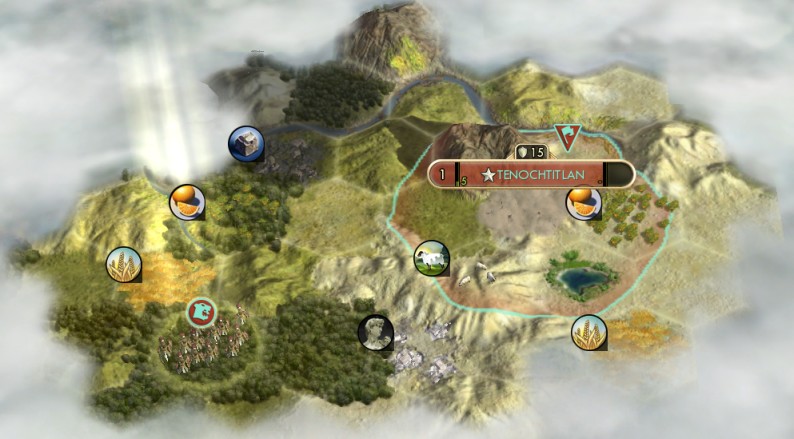
I got this start after not too much rerolling, well under an hour's worth. I'd found that a Tiny map won't generate big swaths of desert, this is about as much as you could consistently get at the capital. So it's not super Petratastic, but it does have a key feature of three 3-yield tiles in the first ring. That will be considerably more important than usual to grow normally rather than from ruins, and the capital won't spend dozens of turns ignoring food tiles while building settlers. Finally, the mountain is also very important since that observatory will represent a significant fraction of 4 cities' beakers rather than 10-plus.
As usual, a few practice and partial starts helped me nail down my opening moves. This plan invoked some changes from my usual routine. The first tech wasn't Mining (no Mining luxury and we don't have to gear up for a dozen starvation settlers), but Pottery because we do have to build the shrine, can't count on a faith ruin. But Tradition means we don't have to build the monument, so that balances out on hammers spent.
And instead of three or four scouts, the right first build was one jaguar. On a tiny map, we obviously need no more than one explorer in each direction. A jaguar moves freely through forest, so can run almost as fast as a scout, and then is strong enough to deal with barbarian camps just like the Shoshone pathfinders.
The right starting build order was jaguar - worker - shrine - archer. With a total of 8 city-states on the map instead of 24, the 310 gold for a worker purchase wouldn't come quickly, so I needed to build one as early as I could manage. The shrine could wait just a little bit since Prince-level AIs are rarely a threat to steal Desert Folklore.
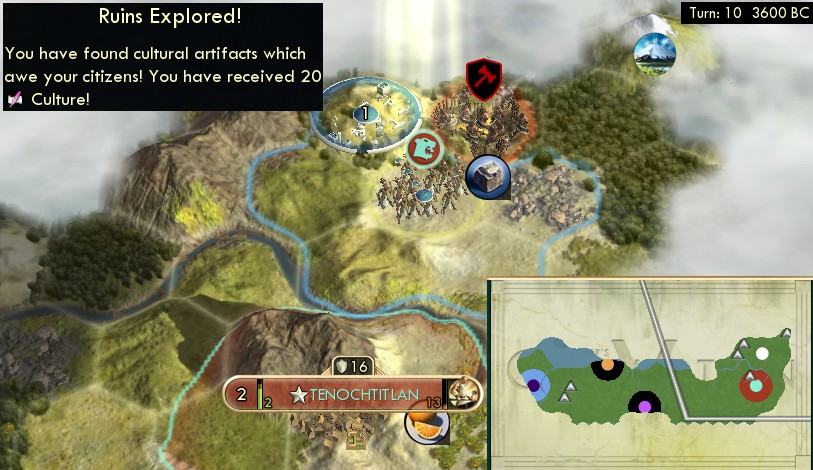
My first jaguar quickly found city-states and a neighboring AI and no ruins. But my second got this one just north of the capital, and rolled the best possible result of culture. Tradition games are much more sensitive to that first culture ruin than are Liberty, since the opener accelerates so much more into the rest of the tree.
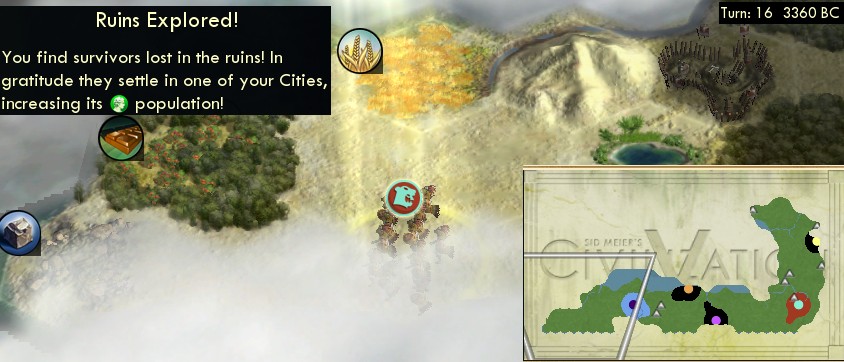
My first jaguar then did get a ruin in the far corner, which also popped what was probably the best possible result, population! Alright, that's about as much as you can expect from ruins on a tiny map. I'd also get a spearman upgrade that would help for killing barbs for culture, although he later died.
Presently I also got my first Aztec kill for culture (by my city itself), which speeded up Oligarchy by two turns on t15. Legalism would follow on turn 26.
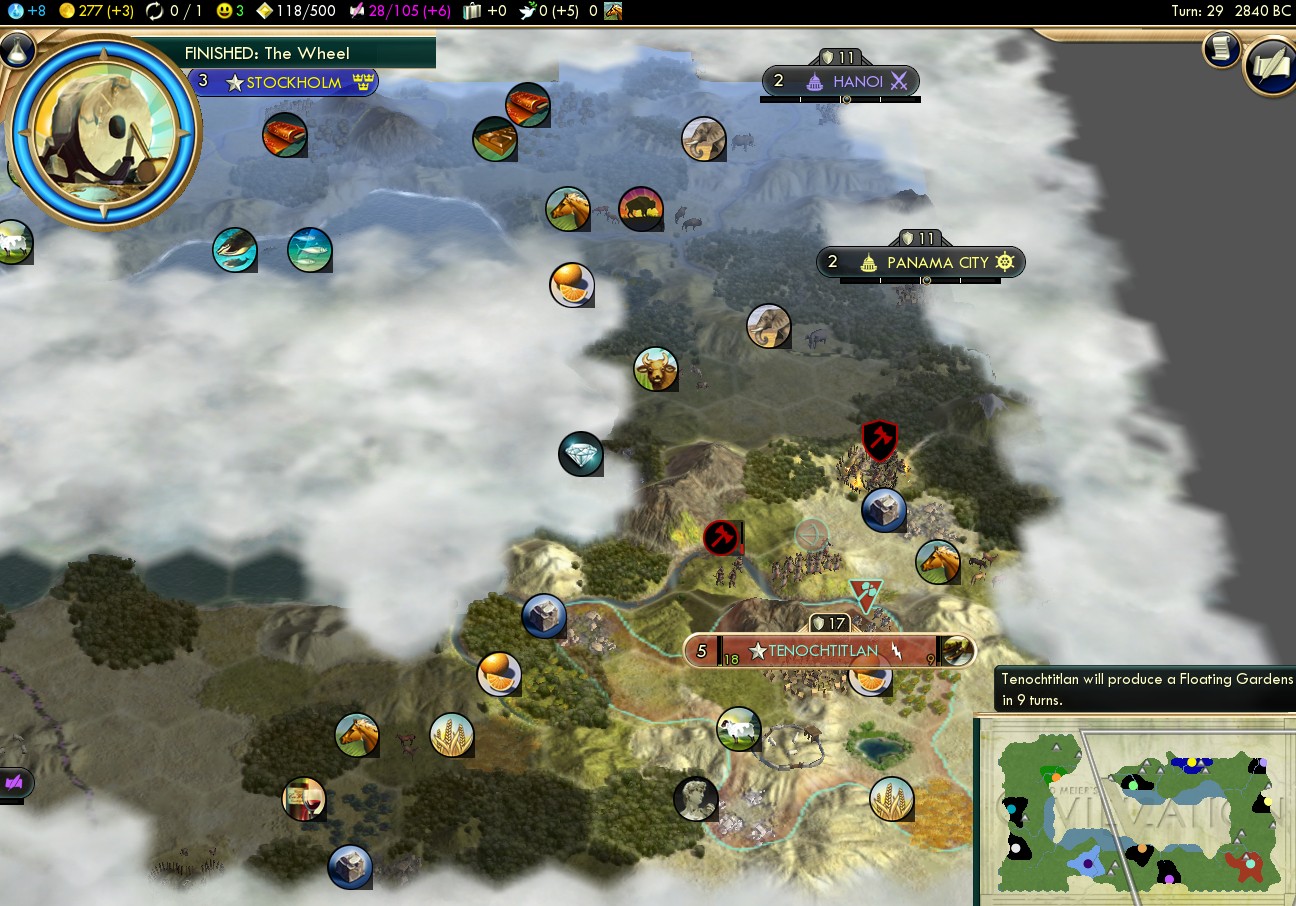
Here's my area, and what a Tiny-size Inland Sea looks like. I just researched The Wheel, to make sure we could build Floating Gardens here. Note that my capital isn't actually on a lake or river, but it turned out that the oasis does count; I'd thought so but wasn't sure.
(By the way, even though the game calls it Floating Gardens, plural, I'm going to use the singular. It's so clunky to try to talk about multiple Floating Gardenses or a singular city building a singular gardens. And I hope that context can distinguish between the floating, regular, and Hanging gardens all when necessary.)
So the picture says floating garden, but then I thought better of it. We needed settlers now and the garden doesn't help with that. I switched Tenochtitlan to settlers instead. Along with that soon came the choice of spending my money on a worker or continuing to save for a settler. I decided a settler was the better buy, since this capital wasn't well set up with hills to build them. And workers can come in more ways, like this:
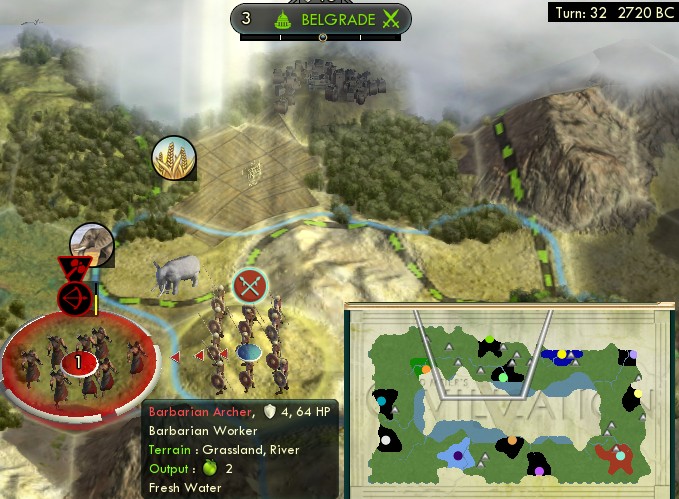
Lucked into a worker retrieval with that spearman one-shotting the barb archer. I kept it. It was somewhat far from home, but I didn't really need a militaristic friendship, 70 hammers worth of a worker now is better than a 40-hammer unit some time away. And I planned to expand quickly north of my capital where this worker would be coming back to.
On turn 40, I improved my first luxury (citrus) and sold it for 4/turn. That might have been a minor mistake, or maybe not. That landed me in unhappiness upon founding a city for two turns until the next citrus got connected. But on the other hand, the money did speed up that settler purchase by several turns.
So Tenochtitlan built two settlers and bought one. I was feeling the pain of missing Collective Rule and the starvation loophole (had no hills). Each settler took 9-10 turns instead of 3-4, but at least we only had to build two. In the policy department, I took Monarchy (turn 37) ahead of Landed Elite (turn 54), since the latter doesn't help build settlers but the former would help buy one. (I always agonize over the decision to order those two policies, and then it doesn't matter as you just take both in sequence anyway.)
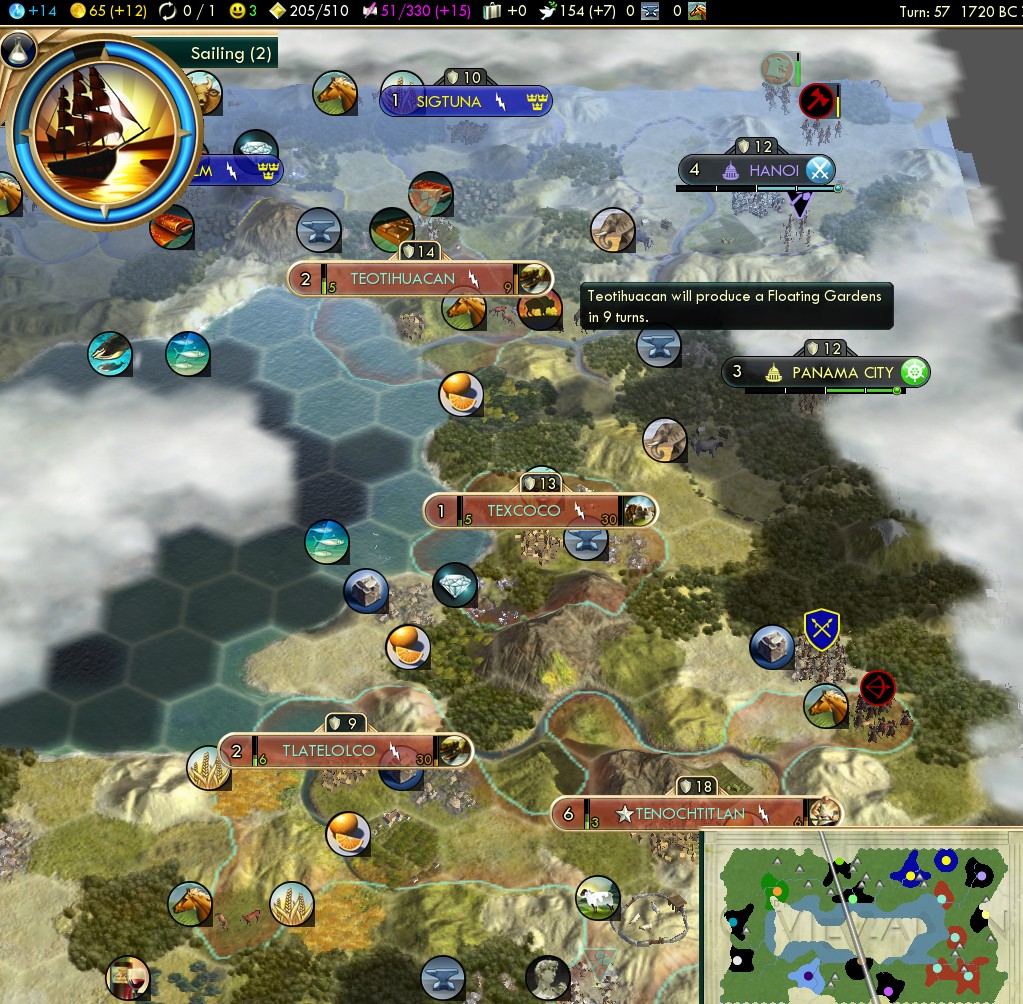
Here we are upon founding the fourth and final city. I was proud of that northern pink dot towards Sweden, grabbing two luxuries that rightfully should have been theirs. That's the key point of why I played out this map despite the low amount of desert: six unique luxuries is pretty hard to do on a tiny map. (Seven if Teotihuacan might someday expand to the fourth-ring whales, which can happen with Tradition.)
Texcoco isn't on fresh water and can't build the UB. I was okay with that: my practice and partial starts had showed that tiny maps seldom result in four good reachable fresh-water locations. What this map did uncharacteristically deliver was three good coastal locations, to swap an eventual total of six sea trade routes between them. That's what a tall civ is supposed to do, make use of the fixed number of trade routes. Texcoco also couldn't do a regular garden either, but the National Epic can make up for that in one city. (Never worth building for 500+ hammers on huge maps, but will be okay at 245 here, actually 213 base modified by Aristocracy.) It does have a mountain to make that spot worthwhile late game.
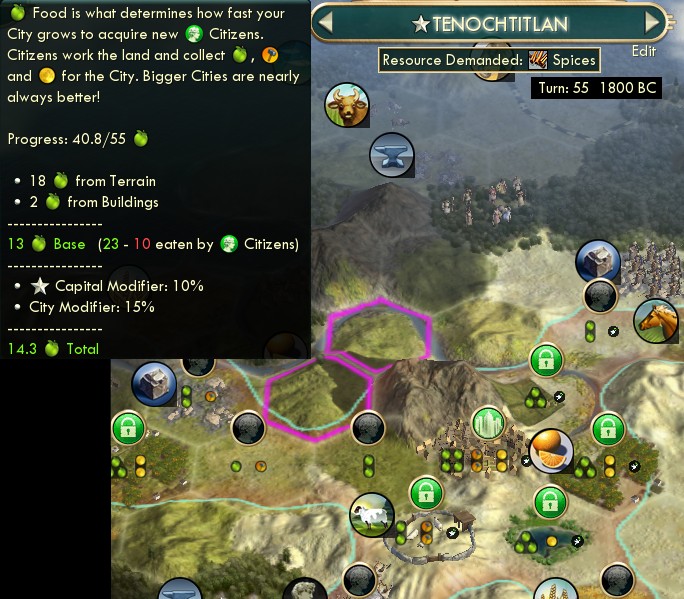
Speaking of the floating gardens, my capital had just built one after the two settlers, and here's what it looks like. The display is a bit screwy. That "13 base" is after the garden already applies, even though it's listed before the modifier. The math is really (18 + 2) * 1.15 - 10 = 13, then Landed Elite applies on top of that (multiplicatively!) to get to 14.3.
That all means the garden is accounting for 3.3 food already. As a civ UA, that would seem to stack up pretty well. That's more than say Greece or Siam's civ ability would be making at this point, and more than Republic that's such a cornerstone of Liberty games. Heck, it wouldn't be long until the garden would be making 6 food, almost like a free Hanging Gardens wonder in each city!
In the previous overview, the one thing going wrong is workers, only two for four cities because I never bought any, pathetically negligent. I'd retrieved the one from barbarians, but hadn't found any steal opportunities. I'd already cleared a camp quest for Hanoi and Panama City (the one and only maritime on the map), so don't wreck that with war.
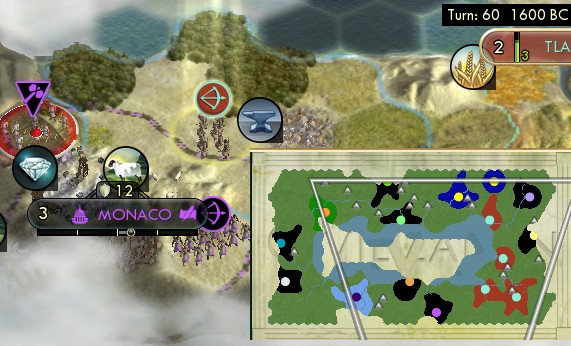
I presently finally got one here, while building one more from the capital as well and eventually buying another.
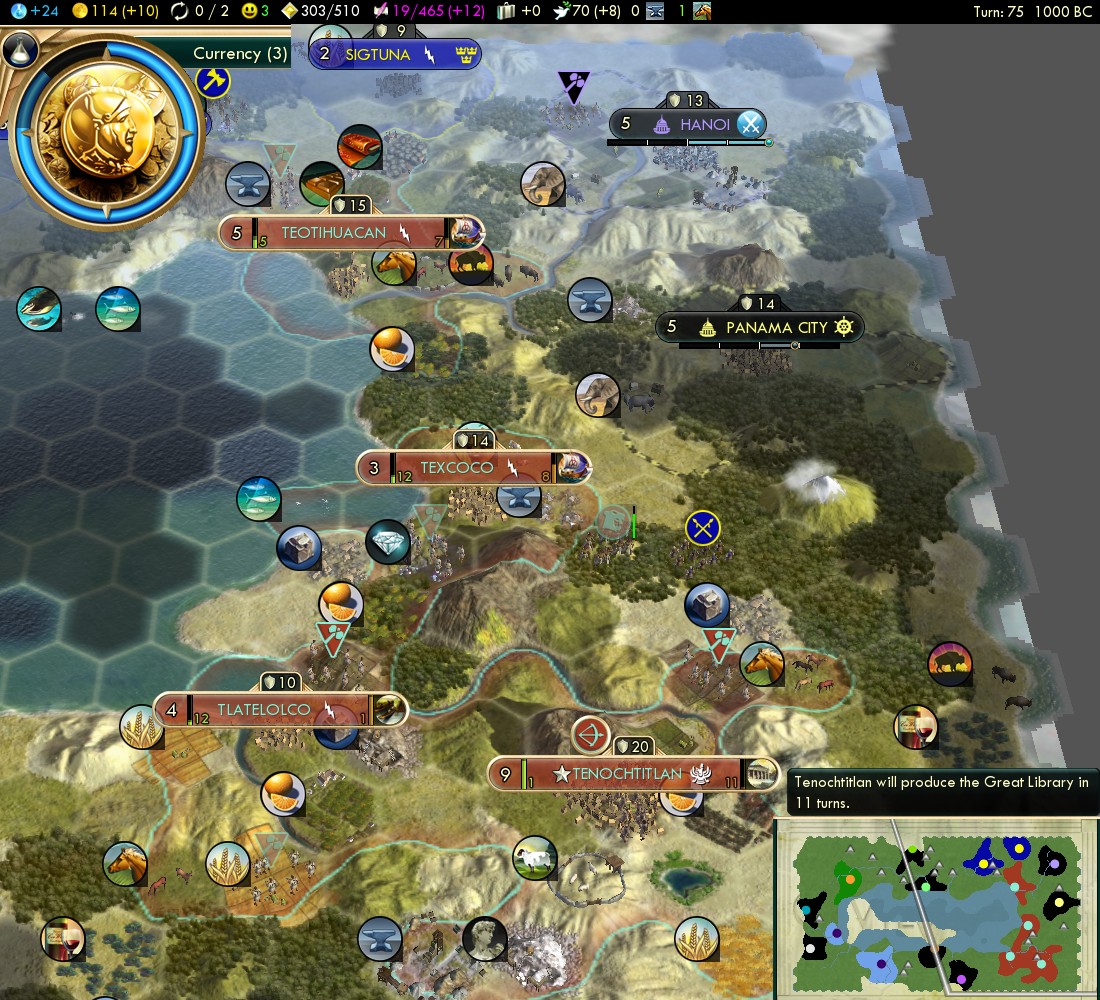
My usual 1000 BC overview. The Tradition finisher had just come on turn 74. I didn't count exactly, but I'd killed something like 16 barbarian units for somewhere around 160 culture total from the Aztec UA, gaining about ten or twelve turns. The ability sounds fun, but no, it is not strong. Compare to Poland, who would have just directly awarded 300 culture worth of that sixth policy instead, and sooner. And of course with thousands more worth of policies to come in the future rather than what would now be irrelevant Aztec pennies.
One thing going right in this picture is setting up the sea trade routes. This is actually amazingly easy to do badly. Possible mistakes include building the cargo ships too soon and forgetting that a granary is required to send food; or building cargo ships too late as you didn't realize how long the city would take to produce a hundred hammers, or of course getting the trade routes pillaged by barbs. But I got it all right here to ramp up this food production quickly. Teotihuacan already built a trireme to protect them, with time to go scouting for natural wonders in the meantime. Then Teotihuacan and Texcoco were both set to complete cargo ships just as Tlatelolco would complete its granary (next after the floating garden) to qualify to send food routes. Of the three, Tlatelolco was the choice to get the granary because it had two wheat.
(It would turn out, though, that food trade routes don't get multiplied by the floating garden. They DO get multiplied by other modifiers like Tradition and WLTKD though, unlike hammer trade routes and multipliers. Some of Civ 5's mechanics are still an ad-hoc mess through the many patches.)
With marble improved and Aristocracy enacted, now it was time to go wonder-crazy. The Great Library was trivially worthwhile, at only 67 base hammers more than a regular library. Although the picture says GL, I would pause it with Currency to do Petra first instead. I kept a close eye on which civs had Writing (only Byzantium for quite a while, then India around now) and watched to see if they ever started the wonder (India did, but in a weak size 4 capital giving me plenty of time for it.)
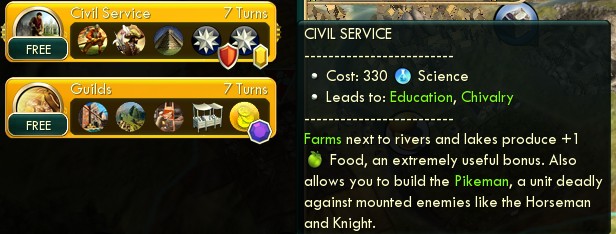
I got Petra, then the Great Library on turn 93... shooting it all the way to Civil Service! Yup, that doesn't happen on Emperor. That's a good slingshot for food snowballing (although I didn't have all that many farms), and just for big beaker value towards Education as well.
More wonders followed: Hanging Gardens next, then National College, Chichen Itza, Oracle in a side city, and later all the usual Renaissance stuff starting with Notre Dame and the Leaning Tower. Didn't do any of the Theology wonders this time, didn't need them.

Religion: The shrine had finished around turn 24 and got me the pantheon on turn 29, mildly slow but that was expected. The first prophet followed on turn 66, also expectedly slow thanks to having only one city's worth of desert.
It took me a while to make this decision, but ultimately I decided that Pagodas weren't the best choice. They would amount to just 8 happy across the four cities, and it would take dozens of turns to buy them with that slow faith production of less than 20/turn. So instead, I went with the two big multiplicative beliefs for tall cities, Swords into Plowshares then Religious Community at enhancement time. (Then I realized I had to make peace with my worker-steal victim city-state to enable Plowshares, heh.)
I'd eventually buy two missionaries with faith. One is standard (convert two cities then snowball the rest by pressure), but here I needed a second, as my fourth city was too big to wait for pressure, and that missionary's second spread also went to good use on a city-state quest. Skipping the pagodas was correct, we really just didn't have the faith to afford them. Reliquary for the enhancer was also correct, we didn't care about the passive pressure spreaders on this tiny map, and we'd need that faith to go towards buying endgame great people.
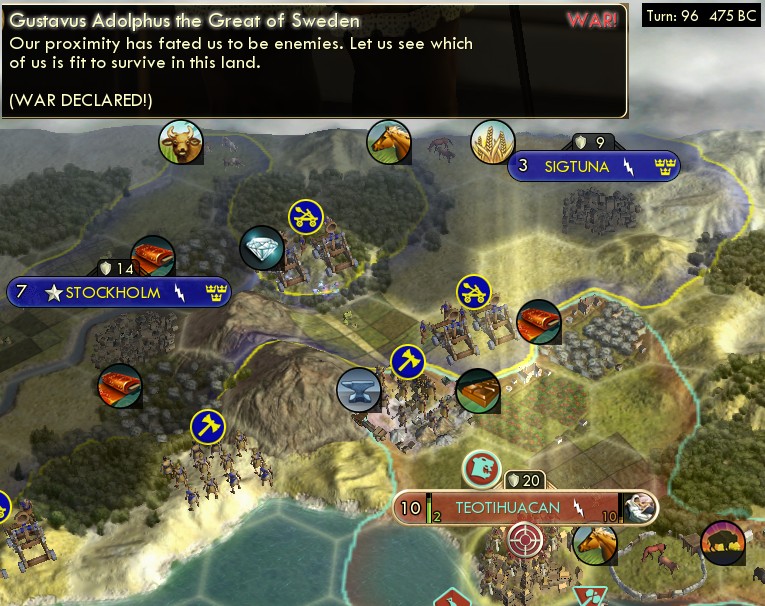
This caught me by surprise - Sweden declared war! I was annoyed not for any chance of losing the war itself (the city with Oligarchy would nearly one-shot units and there was no way the AI would efficiently maneuver around those mountains), but because it would turn off Swords into Plowshares for a while.
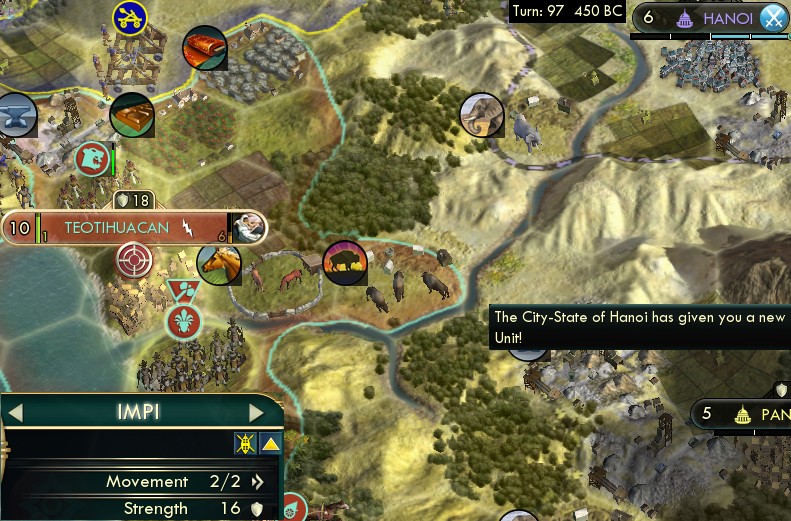
The very next turn, my militaristic ally Hanoi delivered bigtime, giving a unit at the most perfect time and place! And it was an impi, that's kinda an oddball choice, but certainly strong and effective in nearly one-shot killing the catapults. I cleaned them up quickly and the war lasted just five turns before we signed peace.
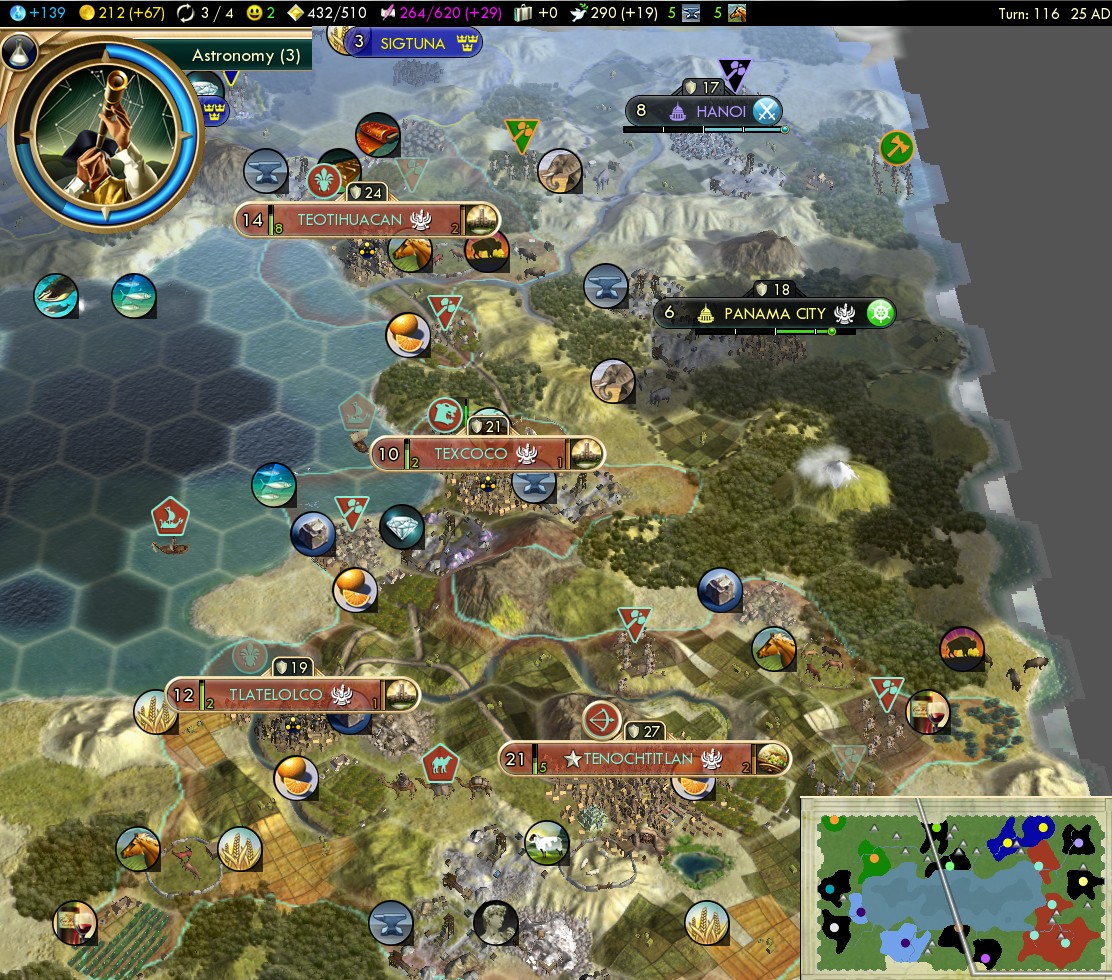
Moving along quickly (because the game did in real time), here's the 1 AD overview (actually a turn late because I missed it.) Education had come in on turn 107, and there's the universities under construction. This date was tied with the Poland Jesuit game, but actually a bit behind as we hadn't needed Construction - Engineering thanks to the Tradition finisher.
This game was moving along amazingly quickly in real time. I typically run about 20 to 30 turns in an evening, methodically checking over all the cities and workers and everything every turn. Here I went nearly 100 turns in one night, almost unheard of for me, but possible thanks to the small amount of cities that were just working all of their tiles anyway.
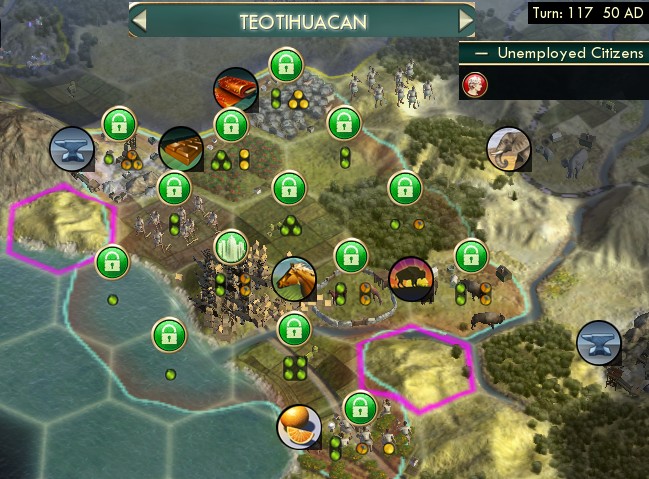
Like this. Yikes, it's working two coast tiles and an unemployed citizen! The tile expansion couldn't keep up -- even with the Tradition opener and having bought two tiles! This is the big downside of missing pagodas, missing the culture. The 2 culture from pagodas sounds like 40 hammers worth of monument, a small number -- but the right number to consider isn't that cost, it's the benefit, and I'd have been happy to build more culture at almost any reasonable price here (no a 100:1 ratio on the amphitheater is not reasonable.)
This city was supposed to get the Writers' Guild to solve the culture problem, but just didn't get to it before we had to build the university and garden. I hate doing this, but I had to just put the guild in the capital since anywhere else would take another twenty turns to get to it.
Turn 103 had come the 7th social policy, for the Commerce opener. I was definitely aiming to enter the Renaissance at Astronomy since we had mountains at half the cities, and there would be time to get there before the 8th social policy (this usually happens without pagodas.)
Presently I finally felt the first happiness crunch of this game. I'd had a good amount of luxuries to get going early, but eventually the small number of city-states caught up with no further luxuries to be had. I had to buy one colosseum and build some more, until Notre Dame relieved that.
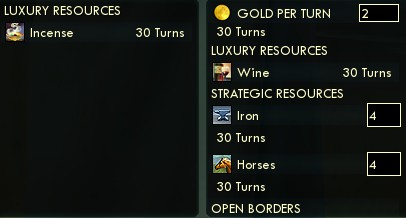
I also resorted to overpaying for Gandhi's only copy of incense. Although cleverly not really paying much of anything at all, doing it all with surplus resources (with just three Prince AIs on the map, they were always too broke to buy my iron and horses.) And this deal rewarded just the happy itself but also three city-state quests.
Although can you spot the mistake in this deal?
Printing Press is always the next Renaissance research target, for both the Leaning Tower and World Congress Sciences Funding to accelerate GPP. The tech came on turn 134... which represents seven turns of lost ground compared to the Poland and Shoshone games. The Jesuit universities really make all the difference in the world in saving turns here in the mid-game.
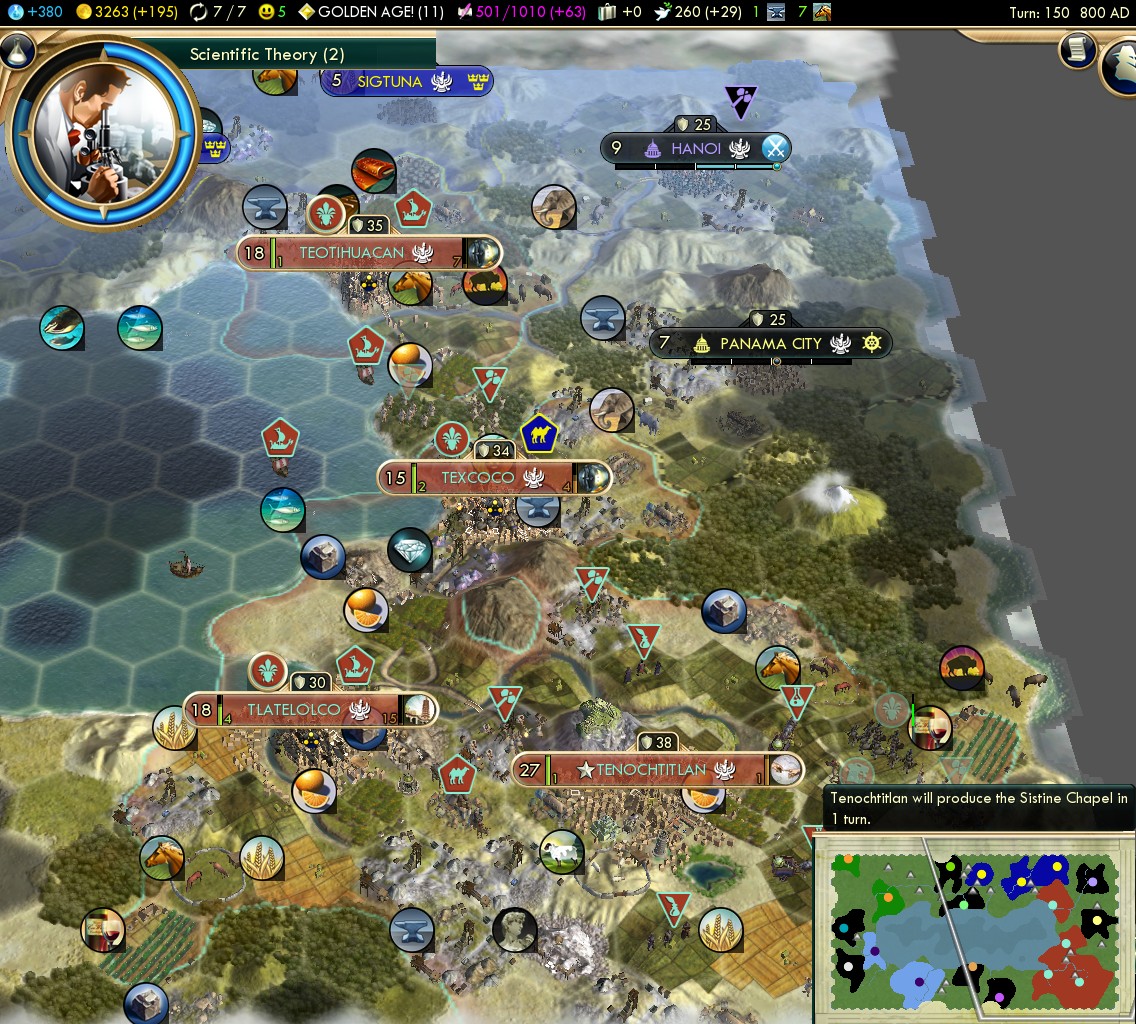
At least I had a clear plan for the next move. Just go straight to Scientific Theory and buy all the public schools. Small games do make significantly more money per city, with fewer roads to maintain and more payoff from each city connection, especially once Machu Picchu completed. I could simply afford all four schools at the full 920 price without worrying about discounts. No need to sidetrack to Industrialization for Big Ben or Order->Skyscrapers. That also let me delay the ideology choice a bit more, still wasn't sure which way to go there.
So that was turn 152 for Sci Theory and the schools... which is 11 turns behind Poland. By now I knew this game wasn't going to be setting any records. Still, I wanted to play it out and see where it would end up.
Policies: One thing you can do on Prince that you can't reliably on Emperor is save the Oracle until the Renaissance and Rationalism. I got that on turn 121 for the Rationalism opener, a much needed kick through that tree. Then turn t126 Secularism, t142 Humanism, t156 Free Thought. Yes, that's slow, 15 turn intervals between policies. I was lagging tremendously on culture production, missing every important piece: pagodas, Liberty opener, cultured city-states. The Aztec ability was now too tiny to matter, even with a few kills from that Sweden war. Although I wasn't really behind on Rationalism itself; what I was missing was Landsknechts and Mercantilism over in Commerce, but that was tolerable.
Turn 160 was eight turns since Sistine Chapel and the industrial cultured city-state value, so that was time to spend my first two Great Writers, claiming Sovereignty now, and also lining up the next policy to come right after Radio for a level-2 ideology tenet.
Electricity arrived next, and I realized with horror that the capital wasn't on a river and couldn't do a hydro plant! But even worse...
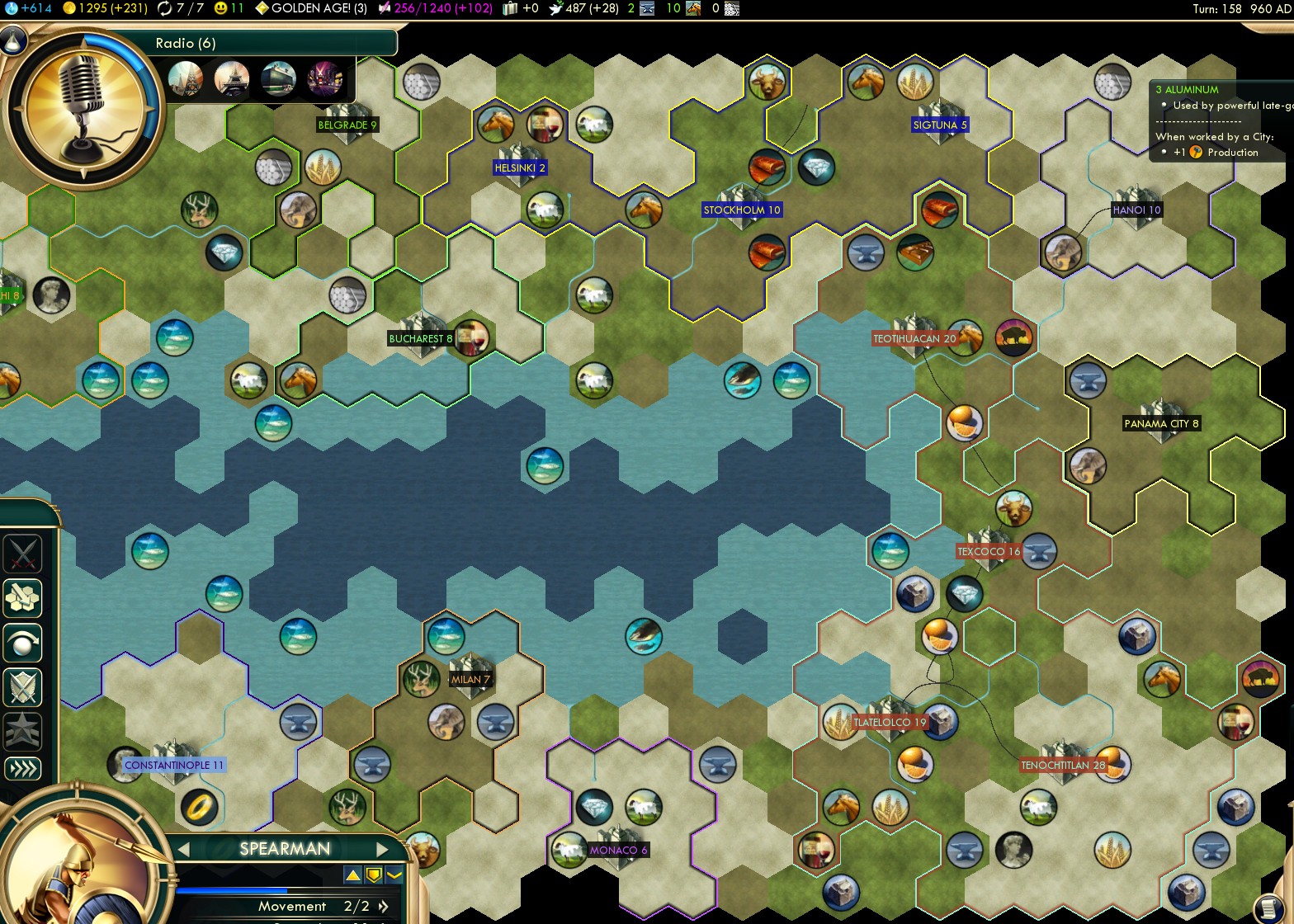
THERE IS NO ALUMINUM IN THE ENTIRE EASTERN HALF OF THE WORLD. The one 3-source (not enough for the ship anyway) is unreachable behind Hanoi. (It'll take about 300 turns for Prince-level city-states to get up to Electricity tech.)
I could go settle a city to claim the two sources by Belgrade and Bucharest, but really didn't want to. Besides the busywork, it would screw up my tech costs by 5% and policies by 10% and so not really give a comparable benchmark on the finish date.
I also toyed with the idea of exiting with a diplomatic victory instead... but that way lies madness, I'll thrust myself into another run of games competing for fastest diplo wins, bad idea, abort, abort.
The one remaining answer was Recycling Centers for the aluminum. Four of them yield 8 copies of the resource which is enough for the ship and two hydro plants. This determined my ideology path: had to be Order. We would need to buy those recycling centers, which meant Skyscrapers and not saving the money for Space Procurements. I was leaning towards Order anyway, seeing how the science production was lagging with too few cities, so we'd need Workers' Faculties and the scientist from Spaceflight Pioneers.
That also set my immediate tech path as Industrialization first to find and mine the coal, then Radio to enable the ideology and Workers Faculties' to build the factories. It would also turn out that I had only three coal! Had to go without one of the factories on top of all the other problems.
Anyway, I reached Radio and Order and Workers' Faculties on turn 168. I then spent three bulbs towards Plastics, reaching it on turn 173. Which again is just too slow, now 13 turns behind Poland. Yeah, it turns out that narrow civs just don't produce as much science. Terminal velocity came to 1000 beakers/turn, compared to 2000 on huge wide maps. But the tech costs on a huge map are much less than double that of a tiny map, actually only about 40% more. The city cost penalty comes out the same either way, 5% per each of 4 cities is the same as 2% for each of 10 cities.
The other problem is Great Scientists, of course. This is what that situation looks like:
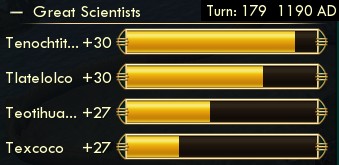
I'm always proud of how great scientist points run in lockstep when you do it right. Thing is, that only works for the first round of GS production, one per city. What happens after that is that the cities will run in *stair*step rather than lockstep. Each city starts its second GS 100 points later than did the previous city... and then also has to go 100 points further to spawn it, a swing of 200 total. In other words, the interval between GSes doubles for the second round of them. (I intuitively knew this but saw it in action for the first time here.)
Anyway, the right approach was still to work backwards from the end of the tech tree to plan out my moves now. I counted ahead to the next Great Scientist spawn dates (turns 183, 190, 201, 209 from the four cities), added up the total cost of the tech tree plus my 1000/turn beaker production, and calculated that the GS on turn 201 would be the one that made for enough to complete all the research. I also had to build some very late shrines and temples to make sure we'd reach 2500 total faith to buy two GS that way.

T183 Socialist Realism, and also spend the last two Great Writers to also reach Five-Year Plan.
Hey... Socialist Realism says to build monuments in half the usual time. That's useless, right, you've always built all your monuments by now. But we could use the same trick as rebuilding Piety shrines to get double overflow!
 Except we can't, because all the monuments are free from Legalism and can't be sold!!
Except we can't, because all the monuments are free from Legalism and can't be sold!!

8 turns past research labs, scientist value is maximized, so I spent them all (four) to Rocketry. This actually didn't help. To build spaceship parts, we needed both Ecology for the aluminum recycling centers and Adv Ballistics to enable the 3 boosters themselves. It wouldn't help to get either of those techs until we got both, plus also the Apollo Program of course, and also Satellites to the Hubble Telescope is another limiting factor.
I spent quite a while solving this puzzle, figuring out how to weave the threads in parallel to line up correctly. I hit on this line of play: build the less expensive Apollo in a secondary city while the bigger Kremlin went in my capital. Kremlin would take the Rationalism finisher for Adv Ballistics and enable buying the two faith scientists to get up to Ecology. This would require one more naturally-spawned scientist first for Nuclear Fission. (Because you can't bulb the faith scientists before claiming the Rationalism finisher tech. They have to wait a turn after purchasing before they can be used.)
But then one more problem actually led me to get fed up and abandon the end of the game here. To finish the tech tree, I still needed yet one more naturally spawned scientist before claiming the endgame ones. But then the next regular social policy came too soon, two turns before that great scientist. It was to be Spaceflight Pioneers... and the two Great People from it bumped up the GP cost counter twice more. That set back the entire sequence another eight turns waiting for that next scientist. But I couldn't pass on Pioneers now and wait for yet another policy to come around, which would take another 19 turns. I really didn't feel like wasting the hours to play through those extra turns, when this game had already proved noncompetitive for finish date.
If these glitches had gone right, the finish would have been around turn 215. Just about on par with the Rome tall game. Sorry for the anticlimax, but not everything goes perfectly well. Well, the whole point of this attempt was to validate my assumption, that wider is better for science, and yes, that did turn out to be true. "I haven't failed, I've merely discovered one way not to succeed."